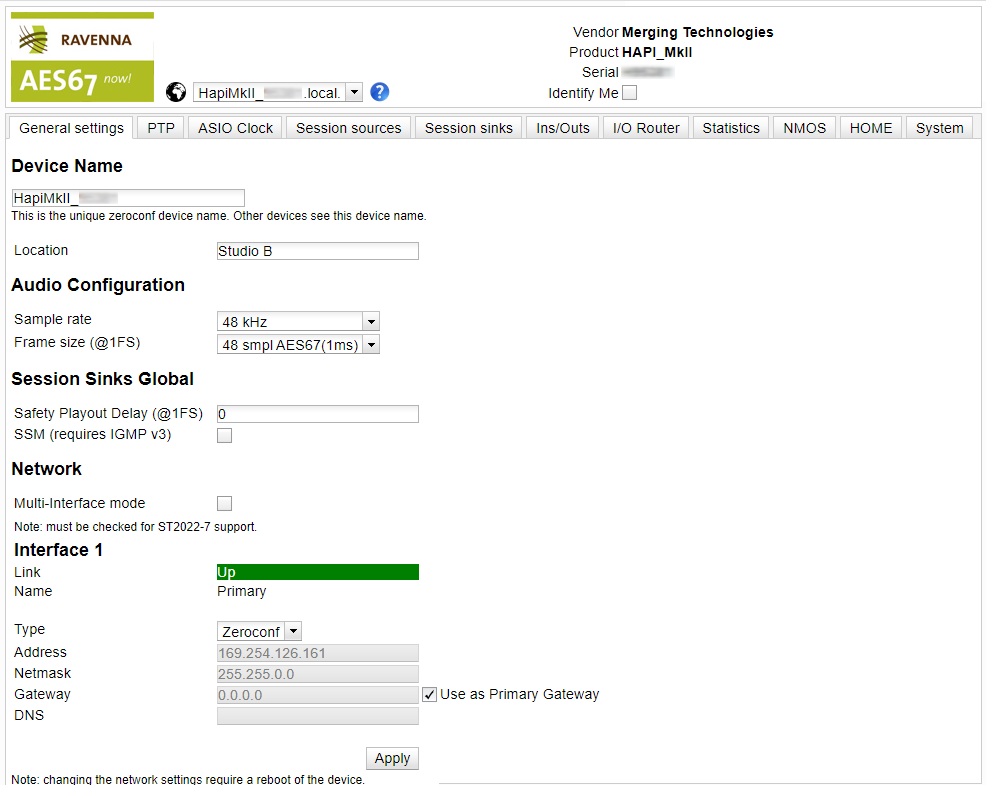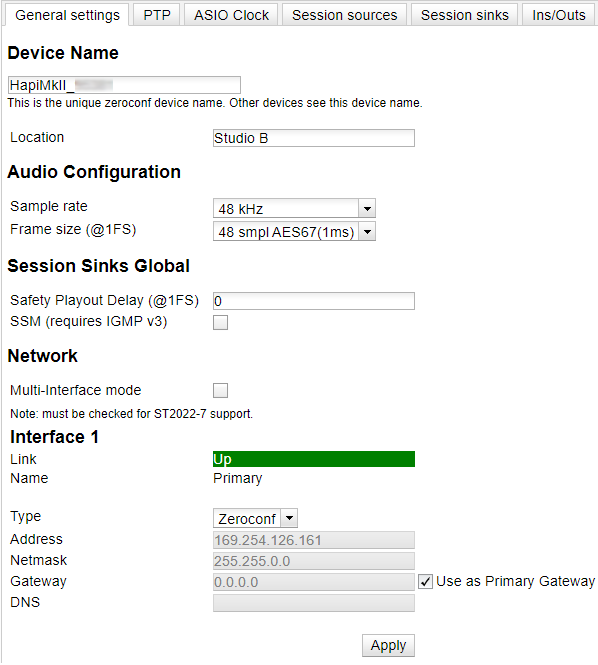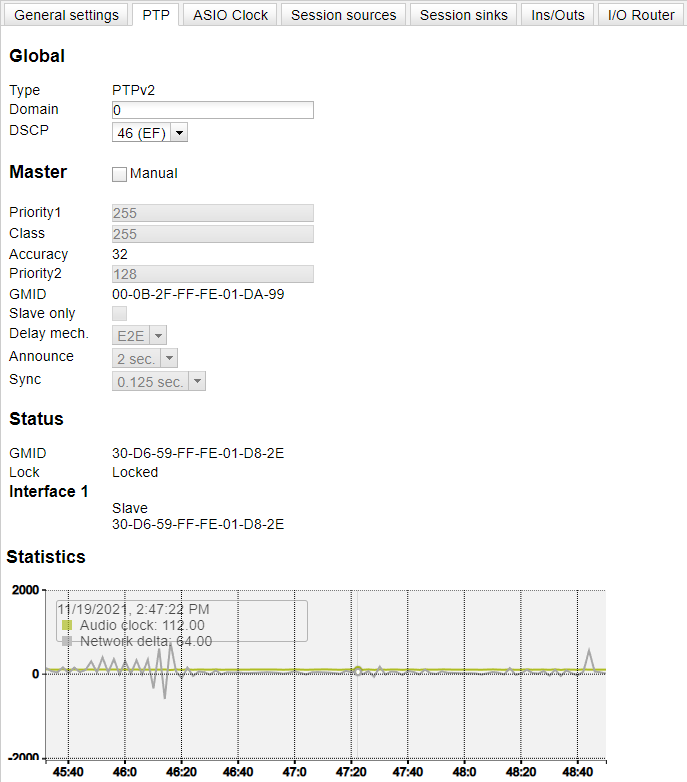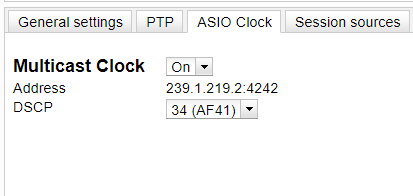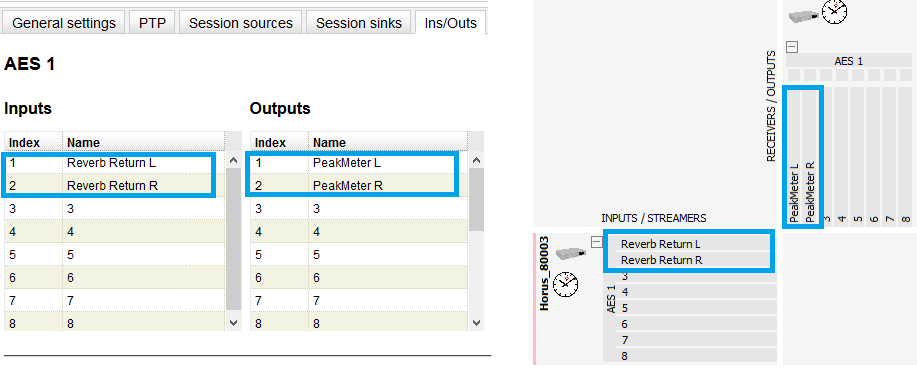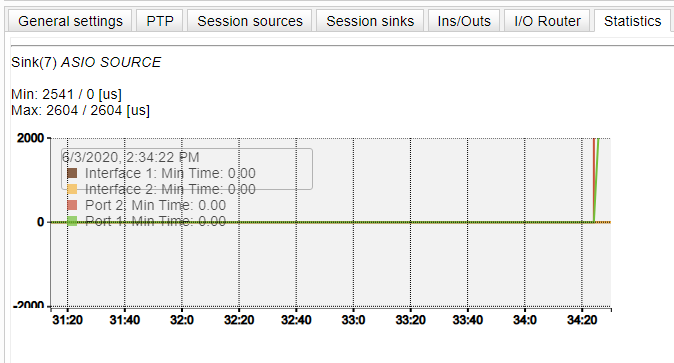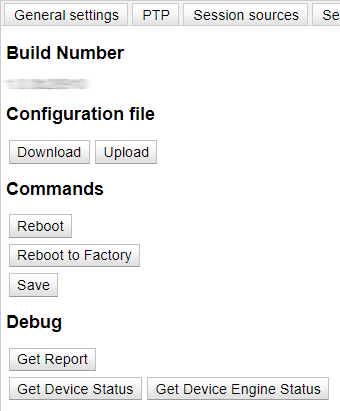Merging RAVENNA Advanced Pages User Guide.
- Firmware_1.7.0_59675.Anubis
- Firmware_1.7.0_59675.Hapi-III
- Firmware_1.7.0_59675.Hapimkii
- Firmware_3.20.0_59675.Hapi
- Firmware_3.20.0_59675..Horus
How to access the Advanced pages
- With the device IP address :
- Horus/Hapi/NADAC/Anubis
In your browser, enter the device IP address followed by /advanced/index.html
E.g: 169.254.80.179/advanced/index.html - VAD (ASIO, CoreAudio, ALSA)
In your browser, enter the device IP address followed by :9090
E.g: 169.254.80.179:9090
- Horus/Hapi/NADAC/Anubis
- Through MT Discovery :
Right click on your device and select Open Advanced (Hardware devices : Horus, Hapi,...) or Open (Software devices : MassCore, ASIO, Alsa,....) - Through ANEMAN :
Right click on your device and select Web Services : Advanced (or RAVENNA if Advanced is not available)
GENERAL SETTINGS
Device Name
- This is the unique zeroconf device name. Other devices see this device name.
Reboot is not required for the change to apply. Equivalent to device Setup menu > Network > Device Name (Horus/Hapi)
Merging recommends to not exceed 32 characters (The device name is translated to UTF8, which support max 63 bytes) - Location : information text (64 characters max)
Audio Configuration
- Sample Rate : current sample rate (44100-48000- 88200-96000-176400-192000-352800-384000)
- Frame size (@1Fs) :current frame size (64 - AES67/48 - 32 -16 - 12 -6).
Note that available frame size values may not be available or differ according to the device and/or firmware.
Session Sinks Global
- Safety Playout Delay (@1Fs) : additional playout delay. The value is described at 1Fs (44.1-48 kHz) in samples.
For example, if the value is 10, the additional playout delay will be 20 at 2Fs (88.2-96 kHz), 40 at 4FS (176.4-192 kHz),... SSM (requires IGMP v3) : Source-Specific Multicast.
If you activate this option, make sure your network switch supports and is configured for IGMP V3.
Network
- Multi-Interface mode : Activate / deactivate ST2022-7 mode - only applicable to Merging devices supporting such feature.
Interface 1-2
Note : depending on the device and firmware, only Interface 1 might be available.
- Link : status
- Name : information only - can't be modified
- Type : defines the type of IP V4 address used (Zeroconf - DHCP - Static)
- Address - NetMask - Gateway - DNS : only available if Type is set to Static.
Reboot is required for changes to apply.
PTP
Global
PTP Domain : allow to define a specific PTP domain, usually when several PTP masters are required in the same network (default value for Merging devices and programs is 0).
- DSCP : PTP DSCP (46-EF : PTP AES67 / 48-CS6 : PTP RAVENNA / 56-CS7)
Master
To modify the PTP setting, you must first tick the "Manual" checkbox.
- Priority 1 is the main priority value.
- Class : Device class. This value should not be modified.
- Accuracy : cant be modified.
- Priority 2 is only used if the other parameters do not allow to elect a PTP master.
- GMID : Current GrandMasterID (PTP Master)
Slave only : forces the Merging device to always be PTP slave.
- Delay Mech.: PTP Profile related - E2E or P2P (Note: MassCore does not use PTP Delay Mechanism)
Announce : PTP Profile related - PTP announcement interval (0.125 - 0.25 - 0.5 - 1 - 2 - 4 - 8 -16 seconds)
Sync : PTP Profile related (0.0625 - 0.125 - 0.25 - 0.5 seconds)
Status
- ASIOClock Host : Master ASIO Clock device IP address (only displayed for Merging RAVENNA ASIO device).
- GMID : Current GrandMasterID (PTP Master)
- Lock : shows if the device is locked to PTP (Locked -Locking - Unlocked)
- Interface 1-2 :
Note : depending on the device and firmware, only Interface 1 might be available.
PTP status :
Master : Device is Master
Slave : Device is Slave
Listening : The interface is not used for synchronization. Statistics (since firmware 3.9.3)
The graph is only active for slave devices. Not available for ASIO device.
Green curve : shows the regulated device delta against the current Master PTP clock.
Grey curve : shows the network delta against the current Master PTP clock, before the device regulation algorithm.
1 is the highest priority, 255 the lowest one.
Merging devices are by default using Priority 127 when set as PTP Master and 255 when PTP slave
ASIO CLOCK
- Multicast Clock : Auto / On / Off the Multicast ASIO Clock (Same setting as the ASIO Clock in Setup > System menu for Horus / Hapi / Hapi MK II and in Settings > Clock for Anubis)
Auto will only activate the ASIO clock on the Master PTP device. - Address : Multicast address of the ASIO Multicast Clock
- DSCP : allows you to set the ASIO Multicast Clock DSCP between 34 (Default), 46, 48 and 54.
If you use a switch, please make sure that the ASIO Clock DSCP has a high value in the switch DSCP to Queue table.
SESSION SOURCES
Configuration
- Create session button : create a new session source
- Enabled : enables the selected source (active by default)
- IO : select the physical input (when applicable)
- Name : Source name (63 characters max)
- Description : information text (64 characters max)
- Output Interface(s) : select the Source output network Interface 1, 2, or Interfaces 1&2 (ST_2022-7)
Note : depending on the device and firmware, only Interface 1 might be available. Auto-unicast - retrieve unicast address+port from sink (RTSP) : automatically retrieve the sink (listener) IP address for unicast connection.
This feature only applies to Merging Technologies devices. See this page for further details- Address : stream multicast address for the selected Output Interface
Note : specific destination port can be manually set in the address field (for example: 239.1.66.25:9000 )
RTP Odd and Even Ports support :
Odd RTP ports are supported since Firmware Horus/Hapi 3.11.2.52601, ZMAN based products (Anubis, HapiMkII, ZOEM) 1.4.4.52601 and Software products VAD 3.2.2.52601, MAD 2.2.2.52601
MassCore currently not supporting odd RTP Ports.
Ports Range :
Multicast Ports range: 1024 to 65535 (since Firmware Horus/Hapi 3.12.5, ZMAN based products (Anubis, HapiMkII, ZOEM) 1.5.2 and Software products VAD 3.2.7, MAD 2.2.8., MassCore 14.1 )
Unicast Ports range: 1024 to 32767
More details in the Appendix section.
- Address sec : stream multicast address for the other Output Interface.
If only one Output Interface is available, the field is greyed out. - User defined : allow to manually enter or modify the multicast IP address.
Note : user defined checkbox is activated automatically when entering a multicast address manually - TTL : Time to Live (also called Hop Limit) - this value should not be modified
- Payload type : RTP Payload type - this value should not be modified
- Codec : L24 - L16 - DSD64 - DSD64_32 - DSD128 - DSD128_32 - DSD256 (bit rate). Note that those values are sampling rate dependent.
- Frame size (samples) : frame size of the current source.
- DSCP : audio DSCP (34: RTP AES67 / 46: RTP Ravenna)
- RefClk PTP traceable: This feature is useful when you want to connect a stream through Internet (e.g. with two PTP Masters (GPS) at each locations), it allows to make connections with devices locked to different traceable PTP Masters.
See also Ignore refclk GMID - accept source locked to any PTP master on the Session Sinks section below. - Channels :
Channel count : number of channels in the stream. The drop down menu allows to select specific channels if the number of channels is smaller than the selected module channel capability (limitation : channels must be contiguous)
The URL of the SDP of this session is : allows to save the Session Description into a file (useful for specific third party devices if manual SDP has to be provided).
Note : Devices in 2022-7 mode will produce a 2022-7 SDP, containing both interfaces session parameters.
If you load such SDP in a non-2022-7 device, only the session parameters from interface1 will be used.
SESSION SINKS
Configuration
- Create session button : create a new session sink
- IO : select the physical output (when applicable)
- Label : Sink name
- Description : information text (64 characters max)
- Source : drop down menu to select a source (both sap and bonjour advertised sources are listed).
Manual : allow to manually enter a SDP - Delay (samples) : playback delay.
0 is automatic delay (automatic delay works for Merging Technologies devices).
For non-Merging devices, if set to 0, the playout delay is calculated based on the SDP a=framecount value.
In any case, the frames must be time aligned; all devices must run an integer number frames from time zero (epoch). - Ignore refclk GMID - accept source locked to any PTP master : This feature is useful when you want to connect a stream through Internet (e.g. with two PTP Masters (GPS) at each locations), it allows to make connections with devices locked to different traceable PTP Masters.
See also RefClk PTP traceable on the Session Sources page. - Ignore refclk Domain - accept source locked from any PTP master : This feature is useful when you want to connect a stream through Internet, it allows to make connections with devices locked to different PTP domains.
- Relaxed check - accept source with lower channel count : allow to connect to a source that have less channels.
- Channels : Channel count : number of channels in the stream. The drop down menu allows to select specific channels if the number of channels is smaller than the selected module channel capability (limitation : channels must contiguous)
Note: Supported RTP ports : 1024 to 65535 (Multicast) / 32767 (Unicast)
Session Info
Session Status :
: The Sink has been created, and waiting for the Source information to connect.
: The Sink is trying to connect to the Source.
: The Sink is connected to the Source.
: The Sink can't connect to the source, see the error message for details.Global RTP Status :
In 2022.7 Mode, the Global RTP Status displays the status for both interfaces.
In non 2022.7 Mode, the Global RTP Status will be the same as the interface status.
: Waiting for connection
: Currently receiving
: Stream is muted, see Interface RTP Status for further details.
: 2022.7 Mode only - one of the interface is not receiving RTP packets properly.
Session name : defined in SDP (usually the same as the source name)
Playout Delay : current playout delay on the selected sink in samples (and ms).
RTSP Host : connected source IP- Interface 1-2
Note : depending on the device and firmware, only Interface 1 might be available.
RTP Status : connection status (interface level)
0x10 receiving RTP packets
0x01: wrong RTP sequence id
0x02: wrong RTP SSRC
0x04: wrong RTP payload type
0x08: wrong RTP SAC
0x20 stream has been muted
0x40: Horus implementation - an incoming stream is muted
0x80: ST2022-7 mode only - both interfaces are not receiving RTP packets properly → muted
Important note : this field is incremental, meaning the error numbers will sum.
E.g. : Stream muted (20) and Wrong payload (4) will be displayed as 0x24.
Clock domain : PTP clock type and domain
Address : Multicast IP address of the selected sink
Payload : Payload / Codec / Sampling Rate / Number of channels
SDP : display detailed SDP information on the current stream.
INS/OUTS
Allows to change the name of module's specific Inputs and / or Outputs. (when applicable)
Depending of the sampling rate, some modules may not be available.
Note : The module has to bet set to RAVENNA mode (Module page Output Source : Ravenna), otherwise it will not be displayed in that page.
I/O ROUTER
ZMAN-based devices only.
Allows to connect physical I/O and Internal device router.
- Max 16 Channels per module : Shows the 16 first channels of modules (only applies to modules having more than 16 channels)
STATIC DISCOVERY
Virtual Audio Device (VAD) only (since V3.2.0.50895)
Allows to declare devices with static IP addresses and ports (JSON format). This feature has been designed for setups where Bonjour cannot be used (e.g. usage of routers).
The declared devices will afterwards appear in the VAD Panel (with their respective icons if online, otherwise with a generic icon if offline)
eg. [{"IP":"192.168.1.99", "port":80},{"IP":"192.168.1.124", "port":80}]STATISTICS
ZMAN-based devices only - Under Construction
NMOS
NMOS General Settings
Note : NMOS Node API (IS-04) V1.2 and NMOS connection API (IS-05) V1.0 are currently supported.
Please also see the NMOS Implementation Notes
- Enable : enable or disable the NMOS client, following the Port and Registration server configuration.
Note : NMOS must be disabled to access the settings. - Port : Device NMOS communication port (unallowed: 80,81,8080)
- Flush streamer address on disable : clears the streamer address when the stream is disable. This option might be useful with some NMOS servers.
- Set UUID from Names : Unique ID created from name. A device restart is required when the name/UUID is changed.
Configure Registration Server
- Mode : Registration Server communication modes :
mDNS (Bonjour): Automatic communication to a Registration Server, using Bonjour service (The server needs to advertise with Bonjour Service)
Search domain: A search domain needs to be supplied.
The search domain associated with the primary network interface is shown as Suggested.
This mode is not yet supported on embedded devices
Static Address: The registration server is found using the address given in the “Address” field.
This is currently the preferred and most common way to establish communication with a NMOS Registration Server. (Sony NMOS CPP, Riedel NMOS,...) - Address : When Mode is set to Static Address, allows to enter the server IP address and port (<ip address>:<port number>).
In other modes, this field only displays information when the communication is established. - Search Domain : When Mode is set to Search Domain, allows to enter a domain (Unicast DNS).
In other modes, this field only displays information when the communication is established.
(Currently only supported on Merging Ravenna ASIO v13.x and VAD 2.1.x)
Registration Server
This section provides status information about the Registration Server.
- Server Name / Host : provided by the Server (with DNS or mDNS). Note that this field may remain empty when mode is set to static
- Address / Port : Server IP address and Port.
- Registered : True If a registration server can be reached.
HOME
HOME
Home Server: NATS server address (alternatively, the Home Server IP address and port can also be entered).
Note : Home must be disabled to access the settings.Enable: enable or disable the Home client, following the Home Server address.
Server address found: Server address found according to the Home Server field.
Registered: Current connection status
SYSTEM
Build Number
Current firmware version
Configuration file
- Download / Upload : Save / Load device configuration (preset file).
Commands
- Shutdown : shutdown the device
- Reboot : restart the device
- Reset to Factory : restore all settings to factory default, and restart the device
- Save : save the current configuration.
Debug
- Get Report : generates a debug report, and saves it on the local computer.
If the report is not saved automatically, make sure your web browser did not block the download. - Get Device Status : displays the device status (SysLog)
- Get Device Engine Status : displays the device engine - ZMAN-based devices only (the report includes the Json Tree of the device)
- Toggle Transparency check : (Merging RAVENNA ASIO driver / Merging Audio Device driver only) : send a transparency check signal on the first output channel (Channel0)
UNIT IDENTIFIER
Identify me : Provides visual feedback on the unit to allow the user to quickly identify a unit (currently only available for ZMAN-based products; Anubis, Hapi MKII).
When ticking the checkbox :
- Anubis displays its Device Name on TFT and flashes its Home button (Merging logo).
- HapiMkII & MKIII flashes its front panel Merging logo.
APPENDIX
Session Sources error codes
-99: Unable to add the Stream : The maximum number of streams has been reached, or if the device is Merging ASIO, it is not started.
Horus-Hapi : The max number of streams is 32 in, 32 out - the number of ASIO Clock.
Anubis - Hapi MKII - ZMAN: The max number of streams is 64 in, 64 out - the number of ASIO Clock.
-100: Channels mapped to unexisting input : The requested input channels are not available. This might happen with modules that have a different number of channels depending of the sampling rate.
-101: Channels must be mapped contiguously : The channel mapping must be contiguous, 1-2-3-4....and not 1-3-7-8.
-102: All channels must be mapped : All the channels from the selected IO must be used (usually 8 channels)
-103: IO not available : The requested IO is no longer available. E.g. AD card removed or not available at the current sampling rate / audio data format (DXD/DSD)
-104: Address collision : The Address is already used by another source.
-105: Address undefined : The Address is missing or not properly described.
-106: Invalid Codec : Codec is missing, or not compatible with the selected IO
-107: Channels mapped to unexisting output : The requested output channels are not available. This might happen with modules that have a different number of channels depending of the sampling rate.
-109: IO with mixed audio data format : The Codec / Data format must be the same between the different streams connected to the requested module.
-110: Requires two media ports: Creating a source which requires two media ports on a system with a single media port (This could happen if reloading a ST2022-7 preset on a system in switch mode).
-111: mDNS registration failed : The device was unable to advertise the source as a Bonjour service.
Session Sinks error codes
-1: Internal error : unknown error
-10: Unknown RTSP error : error in the RTSP.
-19: Sample rate does not match : Source sampling rate does not match with the device sampling rate.
-20: Channel count does not match : Source number of channels does not match with the Sink number of channels. Alternatively to set the same number of channels, you may use the Relaxed Check - accept source with lower channel count option.
-21: SDP: clock domain or GMID does not match : PTP domain described in the Source SDP does not match with the device PTP domain.
-22: SDP: payload does not match : Payload type described in the Source SDP does not match with the Sink payload type.
-23: SDP: connection (c=) missing : Multicast Destination IP is not described in the Source SDP
-30: Channel map collision : The IO / Channels are already connected to another source.
-93: HTTP: retrieving SDP error : unable to retrieve the Source SDP (via HTTP)
-94: RTSP: unicast source unavailable (NADAC ASIO/CoreAudio's unicast sources are not supported by Horus/Hapi) AutoUnicast mode : The current Sink did not provide the required port to the Source. Please note that AutoUnicast is only compatible with Merging Technologies devices.
-95: SDP: unicast address doesn't match : Unicast mode. The unicast address in the SDP does not match the receiver one.
-96: RTSP: retrieving SDP error (firewall?) : unable to retrieve the Source SDP (via RTSP)
-97: SDP: parsing error : SDP not properly described, please check its formatting.
-98: Unable to add the Stream : The maximum number of streams has been reached, or if the device is Merging ASIO, it is not started. The max number of streams is 32 in, 32 out - the number of ASIO Clock.
-99: SDP: Source not properly configured : Source not properly described in the SDP.
-100: Channels must be mapped contiguously : The channel mapping must be contiguous, 1-2-3-4....and not 1-3-7-8.
-101: All channels must be mapped : All the channels from the selected IO must be used (usually 8 channels)
-102: IO not available : The requested IO is no longer available. E.g. DA card removed or not available at the current sampling rate / audio data format (DXD/DSD)
-103: Channel mapped to unexisting output : The requested output channels are not available. This might happen with modules that have a different number of channels depending of the sampling rate. In the device routing menu, please also make sure that the required IO is set to Ravenna (Horus/Hapi) or Unrouted (Zman, Anubis, Hapi MKII).
-104: Invalid Codec : Codec is missing, or not compatible with the selected IO
-105: Channel map not supported : Number of channels / channel mapping is not supported by the selected IO. Depending on the device / IO selected, only channel count set to 8 is supported.
-106: Channels mapped to an already used input : The selected IO is already connected to another source.
-107: Channels mapped to unexisting input : The requested input channels are not available. This might happen with modules that have a different number of channels depending of the sampling rate. In the device routing menu, please also make sure that the required IO is set to Ravenna (Horus/Hapi) or Unrouted (Zman, Anubis, Hapi MKII).
-109: SDP: port number not supported : The RTP port does not follow the standard and is refused ; it is below 1024 or above 32766 (multicast only).
-110: MDNS_support_not_available_error: MDNS (bonjour) not available. SDP must be provided manually.
Incoming/outgoing RTP range
- Addresses : unicast + multicast range [225..239].x.x.[0..254]
- Multicast Ports range: 1024 to 65535 (since Firmware Horus/Hapi 3.12.5, ZMAN based products (Anubis, HapiMkII, ZOEM) 1.5.2 and Software products VAD 3.2.7, MAD 2.2.8, MassCore 14.1 )
Unicast Ports range: 1024 to 32767 - Odd RTP ports are supported since :
Horus/Hapi firmware 3.11.2.52601
ZMAN based products (Anubis, HapiMkII, ZOEM) firmware 1.4.4.52601
Merging Audio Device v2.2.2.52601
Merging RAVENNA AES67 VAD v3.2.2.52601
MassCore currently not supported
External Links
https://en.wikipedia.org/wiki/Session_Description_Protocol
https://standards.ieee.org/standard/1588-2008.html
https://en.wikipedia.org/wiki/Precision_Time_Protocol
